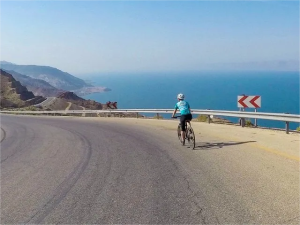The Rock of Dunamase – A Medieval Irish Soap Opera
- by Mohamed Adam

On our recent trip to Ireland, the first stop after leaving Dublin, was the Rock of Dunamase, an impressive rock outcrop towering 150 feet above the flat plain, located some 85 kilometres (53 miles) southwest of Dublin.
The stunning scenery encircling the “Rock” makes it very apparent this was the perfect location for a castle to oversee the surrounding territory.
It became obvious that there was minimal trust or peaceful coexistence back in the day, and its history could have been plucked right out of a Game of Thrones plot (OK, except maybe for the dragons). Quite the medieval soap opera!
The first known settlement the Rock of Dunamase consisted of an Iron Age fort, occupied by Christian settlers. They were plundered and pillaged by the Vikings in the mid 9th century, resulting in the untimely death of the local abbot. That seemed to put an end to any known settlement at Dunamase for centuries.
Occupation was reestablished in the mid 12th century; however significant turmoil engulfed the “Rock” including a kidnapping, a siege, and counter siege, which was the beginning of the much larger Norman Invasion of Ireland in the late 12th century.
In the early 13th century, through strategic medieval politics, an arranged marriage, and consolidation of power (sounds like Game of Thrones, doesn’t it?), Dunamase became the property of the very prominent William Marshall, who was the key architect of the Dunamase Castle in all its dominant glory.
You had better have been in Marshall’s good books when approaching the newly fortified Dunamase Castle which was completed in the early 13th century. If your plan was to lay siege, here is what you would be facing:
A steep hill with cliffs on three sides and heavy fortification on the other, including a deep ditch, drawbridge, archer defended outer wall, murder hole within the outer gate (for pouring hot oil and such on your enemy), open area between the outer and inner walls (nowhere to hide), more archers defending the inner wall, and main gatehouse with an iron grill door, another murder hole, and inner archer slots along the gate corridor.
After that, a long steep climb up to the Great Hall would complete your journey (although I presume the door would be locked).
I think I would wait for a welcoming and warm-hearted invitation myself.
Life remained relatively calm around the castle for over a century until the Irish restored their prominence in the region and executed the last Norman owner of Dunamase Castle for treason in 1330. The castle went into slow decline after the mid 14th century and through into the 17th century even as it changed Irish hands throughout the centuries.
Dunamase Castle was owned by an Irish Earl in the first half of the 17th century, but was ultimately destroyed (blown up) in 1650 along with many Irish castles following yet another English conquest of Ireland (not the best way to be an endearing occupier).
Today, the Rock of Dunamase is a popular tourist destination, yet is not commercialized. It sits quietly in a rural setting, with no kiosks, restaurants, toilets, or organized tours; it just is. One claim to fame is that it was featured in the 2010 movie “Leap Year”.
On our recent trip to Ireland, the first stop after leaving Dublin, was the Rock of Dunamase, an impressive rock outcrop towering 150 feet above the flat plain, located some 85 kilometres (53 miles) southwest of Dublin. The stunning scenery encircling the “Rock” makes it very apparent this was the perfect location for a castle to oversee…




